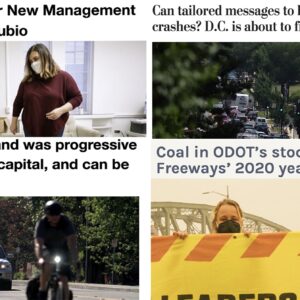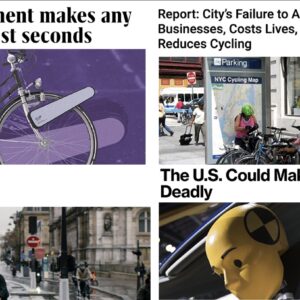
Here’s the top news and other cool stuff that caught our eyes this past week…
– Sightline takes a look at why women don’t ride bikes to work more often and finds the reasons are more complex – and sometimes simpler – than many people think.
– Already a common sight in Copenhagen, an electronic bicycle counter is coming to Seattle (and Portland too! stay tuned!).
– The relationship between bicycling and traditionally car-centric Los Angeles is changing and has improved enough to catch the attention of The New York Times.
– There’s been another instance of road rage between a person driving a car and a person riding a bike on “the Wiggle” in San Francisco.
– Also in San Francisco, a local attorney has been arrested in connection with a fatal collision between someone driving a black Mercedes-Benz and a person on a bike.
– Not only is the bicycle the most efficient form of transportation, it could also become a great platform for new technologies, allowing us to better understand ourselves and our urban landscapes.
– Northeastern University Professor Peter Furth returned from a sabbatical in the Netherlands and recently spoke about his experience at Portland State University. His conclusion: “vehicular cycling” is “just nutty” and on the other hand, separated infrastructure for bicycles is a simple, effective solution.
– Although weather and climate can be barriers to bicycling, it turns out rain isn’t as big of a deterrent to riding a bike as you’d probably think.
– One unlucky couple in Pennsylvania lives in a home that’s been smashed by someone driving a car three times in the last six months and now they want the local government to install a “heavy duty” boulder to prevent future collisions.
– Health officials in developing countries are finding injuries from motor vehicle collisions are much harder to treat when you don’t have access to quality medical medical.
– Portland author and activist Elly Blue thinks we might be able to use the strategy popularized in the movie Moneyball to get more people out on their bicycles.
– Another car manufacturer, Audi, has released their very own electric bicycle and theirs comes with 26-inch mountain bikes tires.
– The Oregonian thinks bikes are to blame for potholes but Eugene’s Register Guard is more than aware of the “myriad benefits” of bicycling.
– Green bike boxes are common in both Portland and Seattle, but one poll finds about half the people who drive in Washington and a quarter of people in Portland don’t know how to correctly approach the devices.
– Scientists are hoping people on foot and on bikes are in a unique position to help count roadkill to help them understand how to reduce collisions between cars and wildlife.
– Thinking of buying a cargo bike? Check out this thorough review of a Bullitt by Josh Volk of Slow Hand Farms.
– People on bikes are often chastised for breaking the law while at the same time many people treat car traffic as an immovable, flowing force and it might happen simply because bicycling puts a human face on transportation.
– Looking to the Netherlands as an example, providing comprehensive safety education could help defuse aggression between people in cars and people on bikes.
– If the return of rain to Portland has you down, just remember: riding a bike can help you keep smiling.
– In a moment of nearly instant-Karma, a bike thief crashed as he tried to ride away from a shop on a stolen bike.
– If you don’t think we can successfully launch a comprehensive road safety program in the United States, check out this “experiment” by National Physical Education Teacher of the Year, Cindy Ferek of Turner Ashby High School:
– And finally, if you’re not familiar with “track cycling” and its impact on bicycling culture, have a look at this documentary by LA based Director, Chicktop.
— Did you find something interesting that should be in next week’s Monday Roundup? Drop us a line. For more great links from around the web, follow us on Twitter @BikePortland.





I did Reach the Beach this year for the first time, and I have to give a shout out to the organizers and the city of Amity, as apparently they learned from their mistakes last year.
I was wondering what would happen as riders rolled through the town, and much to my suprise we were greeted with large road signs announcing the “bike event”, as well as flaggers and cops controlling the traffic.
Everything seemed to be running smoothly, and I didn’t see anyone having problems. Way to turn a potential problem area around and make sure no one had their day ruined!
I had the same gratitude towards both the town of Amity and the organizers of Reach the Beach for patching up what could have easily become a more long-standing conflict. Hopefully there are some in-depth bikeportland reports to come covering the ride this year?
What happened last year at Reach the Beach? I just did it for the first time (my first century, hurray!) and saw the signs up around Amity warning folks that bikes would be targeted for tickets if we didn’t stop completely at stop signs (and I did see one bike pulled over by a cop and getting a ticket a bit outside of town). But this sounds different than just tickets.
I did get yelled at once near Amity, and it was terrifying, by two young guys in a red sports car. They were obviously trying to scare cyclists, too.
Oh, nevermind, just found the information from last year:
http://bikeportland.org/2011/05/23/reach-the-beach-rider-fumes-at-317-tickets-in-amity-53415
http://bikeportland.org/2011/05/23/amity-police-chief-responds-to-reach-the-beach-ticketing-incident-53487
the Urbanadonia piece is excellent. Thanks!
re: rain isn’t as big of a deterrent to riding a bike as you’d probably think.
Funny, rain directly impacts my desire to ride, and did so today. It’s not even really the ride or rain that bugs me, it’s putting on the clothes necessary to do the ride successfully.
I will confess that I was a bit glad to see the rain today because I knew the bike lanes would be a lot less crowded than during some recent commutes. I was right.
Completely agree – as much as I may enjoy the long term benefit of a pro-bike event like last week’s Bike To Work Week/Day, I really enjoyed my commute today even if I was soaking wet when I got to work. The influx of well meaning, but poorly skilled riders makes the commute less a joy and more a practice in patience.
Jonathan, I think that the Canadian study is showing that weather and especially rain NEGATIVELY impacts ridership:
“More days of precipitation per year and more days of freezing temperatures per year were both associated with lower levels of utilitarian cycling”
You’re right that the study shows rain negatively impacts ridership but what I think is important is it’s not a total show-stopper like many people assume.
Sure, Peter Furth is right about the success and safety of separate bicycle facilities in European cities. But the European model certainly doesn’t demonstrate this about vehicular cycling: “It just doesn’t work. It’s just nutty.”
Even in the Netherlands, there is no separate facility up to every door. Eventually cyclists have to leave the cycle track, and they share the roads with other users, where they are expected, accepted, and respected. That’s the core of the European model–it begins with the social understanding that the roads are shared public spaces, not automotive conduits.
There shouldn’t be such a dichotomy between vehicular cycling and separate facilities. Engineering solutions do improve safety and increase ridership, especially in high density areas. But since we can’t build a bike bath to every door, we also need to get along in traffic at some point. There will always be a need to act like a vehicle.
This is backward.
The core of the European model is an understanding that bikes ride on separated bike facilities. Do you really think European drivers love it when cyclists weave between lanes and take the lane? Guess what, we don’t know because they don’t have to worry it. When drivers and cyclists are forced to share the road in Europe it’s done with an understanding.
Why don’t drivers get upset at pedestrians who walk on the side of the street when there isn’t a sidewalk? Why isn’t there an animosity there as with cyclists? Because most of the time there are separated pedestrian facilities (sidewalks) and an understanding that, for whatever reason, in certain areas they don’t exist.
I’ve pedaled many miles in Europe. Most of it was on roads, with cars. I was treated with respect. The wonderful facilities which receive so much attention are only in highly-trafficked areas. Not only that, most are relatively new. They were built to reflect the reality that bicycles were welcome everywhere, but they couldn’t be safely accommodated where cars dominated. They are not the core of the European bicycle philosophy, by any stretch.
My European experiences have been the same. It seemed bikes were simply considered part of the road environment. Drivers were more used bikes on the road.
This is the real key to success, even with separated cycleways. I tend to think that in the U.S., we are deluded to believe that separation = safety. True safety is only achieved when everyone abides by common principles that allow for cooperative usage of street space and require much more attention than U.S. drivers are willing to commit to. What we seem to want in America is a bikeway system where cyclists can be out of sight and out of mind for drivers. To that end, many separated bikeways that I have encountered (in the U.S.) are usually glorified sidewalks that seem to place the onus of “safety” on cyclists by requiring them to stop or yield to oblivious motorists at the more frequent crossing points (intersections and driveways) that those separated facilities create. For me, that has the effect of deterring me from using them and instead preferring the “vehicular” method of just riding in the street where I don’t have to worry as much about drivers lurching into me from the side because they have no incentive to stop so far back from the street they are gunning for.
Until we have a legal and cultural shift that places the burden of operating safely on those who are doing the actual killing on our streets, merely designing bird cages for cyclists is not going to be as successful as their proponents are hoping.
I’ve lived 10 years in Europe and couldn’t disagree more. The cities that I visited and lived in (and drove in) didn’t have cyclists taking the lane and darting in and out of traffic. They just didn’t and to think otherwise is incorrect.
Are there separate bike lanes in the countryside. Of course not. But you’re treated with respect there because you don’t have to be dealt with in the city.
Maybe it was different 20-30 years ago. I don’t know.
May I ask which city(ies)? Just curious since my experience is that bicycling importance/planning widely varies throughout Europe. Just name-checking Europe doesn’t clarify much.
Oh, and I ask specifically because I’ve biked through the Netherlands and they do have quite a few separated bike paths in the country side there (and I remember quite a bit in Belgium,too), so I’m just wondering where exactly you are basing your Euro experience on.
Separate facilities for pedestrians and drivers seems to work alright, or should we just have pedestrians walk in the streets with cars.
Your entire comment reflects the problem. You don’t want to take ANY responsibility for the safety of cars, pedestrians, or other cyclists IF it inconveniences you.
The answer is separate facilities. Maybe it’s too expensive, but it saves lives. Will it inconvenience cyclists? Yes.
From the article about cars crashing into that house in PA:
“The couple has wanted to put a boulder in front of their house to prevent accidents from damaging their home, but they said they have been told that such an obstacle would make them liable for any damage to a rogue driver.”
How can you be liable for people that crash into objects that you place on your private property? Can someone explain this?
Q:
A:
We live in the U.S., where burglars can sue homeowners for getting injured while robbing them.
Exactly. In America, when there is an accident our “fault” driven system forces us to sue each other to get our health care costs paid. Even if the person who gets hurt is insured, their insurance company will not pay if it thinks some other party could be held liable. Trauma care is far too expensive for almost ANY individual to be able to pay out of pocket, so guess what happens …
Exactly – we have poorly designed legislation/laws. Purposely poorly designed much of the time, of course.
Absolutely correct. Portland’s key facility, the Neighborhood Greenway, is an inherently vehicular approach to facility design. The shared lane markings are located to place the bicyclist in the center of the lane, controlling their space safely and securely.
But what Portland recognizes and the hardcore vehicular cyclists don’t, is that the comfort of controlling the lane drops as the speeds and volumes of vehicles around you increase. Once speeds get above 20 mph, and volumes exceed 2,000-3,000 cars per day, separation is the best strategy to comfort ad security to all interested users. When Peter Furth talks about VC being “nutty,” I’m sure he’s referring to these high-stress situations.
“hardcore vehicular cyclists”
The mythical VC bogey man who advocates that grandma and her nephew take the lane at 20 mph on a busy arterial is a straw man.
amen.
Actually, I met several of these folks on tour in the South last month. They can be quite convincing when they get up in front of their city council, call themselves bicycle advocates, and demand an end to spending on anything bike-related except for education.
you met conservatives who are against government spending in the south?
Reach the Beach was great again this year. I am always so impressed with the organization. Amity went smoothly, and I find that the organizers are good about responding to issues with good solutions the following year. Amity is a good example of that. I have been on the ride 6 times now to support the lung Association. I met cool people and appreciate all the friendly volunteers. Already looking forward to next year’s ride.
“It’s just nutty.”
Thousands of cyclists take the lane each day in PDX without copenhagen-style infrastructure. Taking the lane (VC cycling) is an essential skill for utility cyclists in north america. Why the need to insult and demean?
Peter Furth mentions European studies supporting safety of separated cycle tracks as if this is a settled issue.
Copenhagen:
“…the main results are that bicycle paths impair traffic safety and this is mainly due to more accidents at intersections, and that there has been no improvement in the design of new bicycle paths compared to the older ones….”
http://vbn.aau.dk/files/14344951/agerholm_et_al._bicycle_paths.pdf
Berlin:
“Because the separation of different types of traffic by means of sidepaths behind curbs makes excessive demands on users and leads to crashes, other solutions are being increasingly recommended for channeling bicycle traffic.”
http://www.bikexprt.com/bikepol/facil/sidepath/adfc173.htm
Munich:
http://bikeportland.org/2011/11/08/guest-dispatch-from-munich-where-cycle-tracks-have-fallen-out-of-favor-61674
“The hottest issue among bicycle advocates in Munich appears to be the fight to eliminate rules obligating people on bikes to use narrow cycle tracks.”
_ _ _ _ _ _ _ _ _ _ _ _ _
The argument that cycle tracks caused the increases in mode share in Copenhagen and Amsterdam does not hold. Mode share in these cities was high prior to the spending of millions on infrastructure in the 80s and 90s.
I really like the video of the drivers ed class using bicycles as car stand ins. Hopefully many of these kids keep riding bicycles instead of driving. And when they do drive I hope they remember that their is a human being on that bicycle and they are driving a 2 ton guided missile.
House hit by autos *3:
Saw this in Providence, RI – a traffic lighted T intersection where the “stem” of the T was 15MPH with speed bumps down a rather steep grade.
Eventually more than 3 large ugly steel bollards over 12″ in diameter and 4′ tall were placed in the front of this otherwise pretty house.
Well lit intersection and blinking lights highlighted these yellow and black stripped bollards but monthly you’d see fresh “CAR”nage.
the current issue of bicycling magazine includes a review of “four best cars for cyclists,” including the range rover at 52k rated 18/28 mpg. i actually do not care what they think is a good city for cycling.
thank god L.A. has big plans ahead of them. We are moving down there in the fall and was not very exited about it. that made my day
Cheers
Why women don’t ride to work more?
Have you rode in Seattle before? It is nothing but hills in every direction, some of them are seriously steep.
Why would anybody in Seattle want to ride to work?